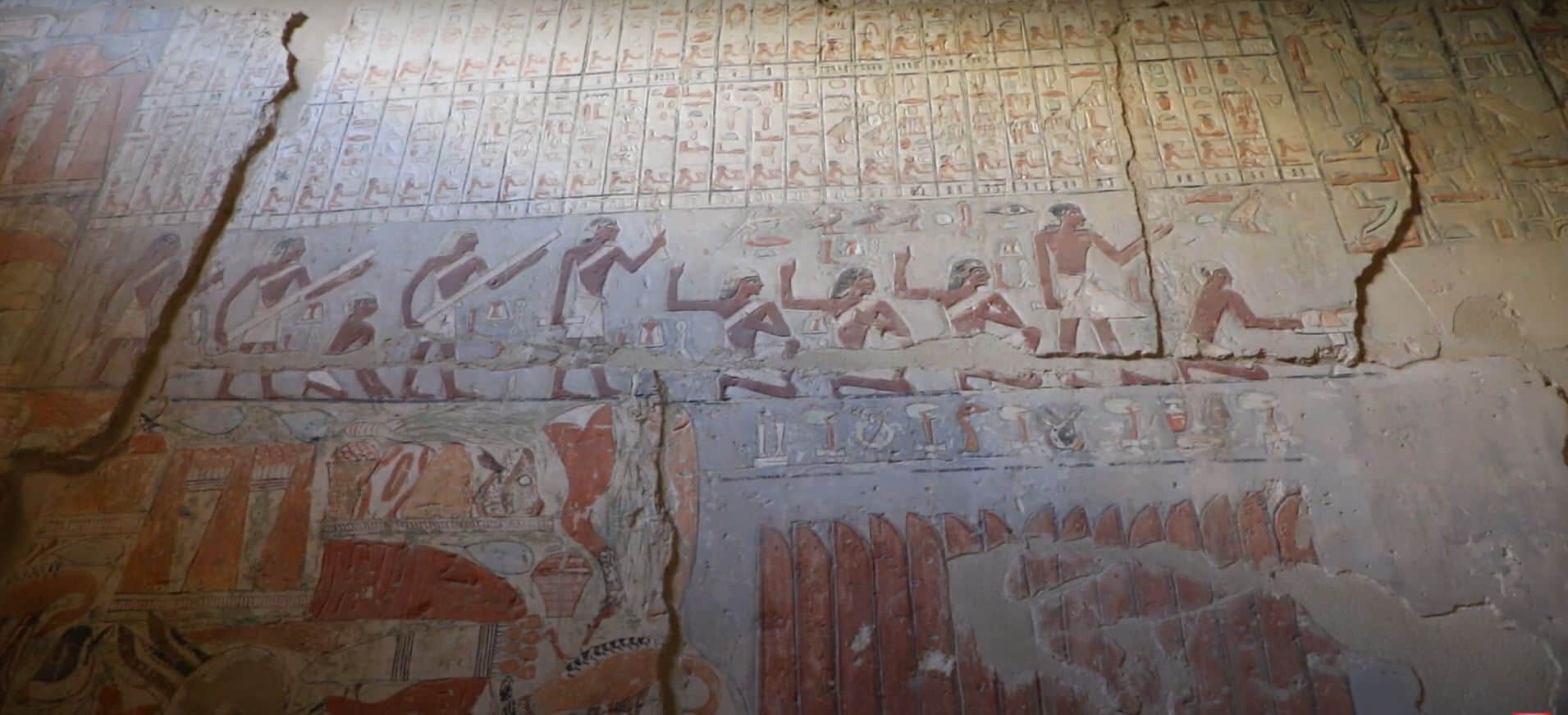Tombs of the Nobles Saqqara – Ancient Egypt

Updated On: March 07, 2024 by Ahmed Samir
In the shadows of Egypt’s iconic Pyramids of Giza lies a lesser-known treasure trove of history and culture—the Tombs of the Nobles Saqqara. While the Pyramids have long been celebrated as symbols of ancient Egypt’s grandeur, the Tombs of the Nobles in Saqqara offer an intriguing alternative narrative, shedding light on the lives and legacies of Egypt’s elite during the Old Kingdom era.
This article embarks on a captivating journey through time, exploring the historical significance, architectural marvels, artistic wonders, and profound cultural insights in the ancient tombs of Saqqara’s nobility. As we delve into this enigmatic world, we unearth the secrets, stories, and spiritual beliefs that have endured for millennia beneath the desert sands.
The Significance of Saqqara
Saqqara, situated just south of Cairo, served as a prominent burial ground for Memphis, the ancient capital of Egypt. Its strategic location along the banks of the Nile River made it a desirable final resting place for the elite and noble class during the Old Kingdom, which spanned from around 2686 to 2181 BCE. The grandeur of Saqqara’s tombs is a testament to the importance of this site in ancient Egyptian society.
The Old Kingdom, often called the Age of the Pyramids, saw the construction of monumental pyramids as tombs for pharaohs. Still, the Tombs of the Nobles in Saqqara reveal a different facet of the era. These tombs provide insights into the lives of high-ranking officials, priests, and administrators who played crucial roles in the administration of Egypt during this period.
Architecture and Design of Tombs of the Nobles Saqqara
The Tombs of the Nobles in Saqqara encompass various architectural styles and designs, reflecting the diversity of Egypt’s elite class during the Old Kingdom. Some of the tombs are relatively simple and modest in size, while others are more elaborate and grandiose, rivalling the pyramids in their complexity.
One of the most famous tombs in Saqqara is the Mastaba of Ti, which belongs to a high-ranking official named Ti. This tomb is characterized by its impressive architecture, featuring an imposing rectangular structure with sloping sides. The tomb’s intricate wall reliefs and inscriptions depict scenes from Ti’s life, including his participation in hunting expeditions and interactions with family and gods. These scenes provide valuable information about the customs and beliefs of the time.
Another notable tomb is the Mastaba of Mereruka, which belonged to a vizier during the reign of Pharaoh Teti. This tomb is renowned for its size and complexity, consisting of multiple chambers and corridors adorned with colourful and well-preserved reliefs. These reliefs depict daily life in ancient Egypt, including agriculture, hunting, and religious rituals.
The Tombs of the Nobles also include some tombs constructed in the rock-cut style instead of the more common mastaba style. The Tomb of Ptahhotep, for example, is a rock-cut tomb that is particularly famous for its wisdom texts, known as the “Maxims of Ptahhotep.” These texts offer valuable insights into moral and ethical values in ancient Egyptian society.
Art and Decoration
The decoration of the Tombs of the Nobles is one of their most captivating features. The walls of these tombs are adorned with intricate and vibrant reliefs that provide a visual narrative of the lives, achievements, and beliefs of the tomb’s occupants.
The scenes depicted in the reliefs cover a wide range of subjects. Some show daily life activities, such as farming, fishing, and cooking, giving us a glimpse into the everyday existence of the nobility. Others portray religious ceremonies, with offerings being made to gods and goddesses. These scenes reflect the deep religious convictions of the nobles and their desire for a prosperous afterlife.
One common motif in many tombs is the “false door.” These false doors were believed to serve as a portal between the world of the living and the world of the dead, allowing the deceased to interact with their living relatives. The false door typically featured a carved image of the deceased, along with offerings and inscriptions.
The inscriptions on the walls of the tombs are written in hieroglyphics and provide valuable information about the individuals buried there. Names, titles, and genealogies are commonly inscribed, allowing archaeologists and historians to identify and study the occupants of these tombs.
Tomb of Kagemni: A Masterpiece of Ancient Art
Among the many tombs in Saqqara, the Tomb of Kagemni stands out as a masterpiece of ancient Egyptian art and craftsmanship. Kagemni was a high-ranking official during the reign of Pharaoh Teti, and his tomb is a testament to his status and importance.
The Tomb of Kagemni is renowned for its detailed and beautifully preserved reliefs covering nearly every inch of its walls. These reliefs depict various scenes, including agricultural activities, hunting expeditions, and religious rituals. The artistry and attention to detail in these reliefs provide valuable insights into the aesthetics and artistic techniques of the Old Kingdom period.
One of the most famous scenes in the Tomb of Kagemni is the “Bringing of Offerings.” In this depiction, Kagemni and his family present offerings to various deities. The precision and intricacy of the carving are remarkable, with each figure carefully rendered and imbued with a sense of vitality.
Another notable feature of the tomb is the vivid depiction of the afterlife. Kagemni’s tomb includes scenes of the deceased enjoying the pleasures of the hereafter, such as feasting, hunting, and playing board games. These scenes reflect the ancient Egyptian belief in the continuity of life after death and the importance of preparing for the afterlife.
The Tomb of Kagemni is a testament to the artistic achievements of the Old Kingdom and a valuable historical and cultural treasure that provides a window into the beliefs and aspirations of ancient Egyptian society.
Burial Practices and Beliefs
The Tombs of the Nobles offer valuable insights into the burial practices and religious beliefs of the ancient Egyptians during the Old Kingdom period. While the pyramids were reserved for pharaohs, the nobility had distinctive customs and rituals.
One common feature of these tombs is the inclusion of a burial chamber, where the deceased was interred, along with funerary goods and offerings. The belief in an afterlife was central to ancient Egyptian religion, and these tombs were designed to ensure a smooth transition to the next world. The offerings in the tomb were meant to sustain the deceased in the afterlife, while the elaborate scenes and inscriptions on the walls were a guide and reminder of the individual’s life and deeds.
The false door, a recurring element in many tombs, played a crucial role in the burial ritual. It was believed that the deceased could pass through the wrong door to receive offerings from the living and communicate with their family. The inscriptions on the false door often included spells and prayers for the deceased’s well-being in the afterlife.
Another notable aspect of the Tombs of the Nobles is the inclusion of small statues known as “shabtis” or “ushabtis.” These figurines were placed in the tomb and were believed to come to life and serve the deceased in the afterlife, performing any labour or tasks that might be required.
The Tombs of the Nobles also reflect the importance of the ancient Egyptian concept of ma’at, which represented the principles of truth, justice, and balance. The depictions of the deceased engaging in virtuous and honourable activities emphasised their adherence to ma’at and their worthiness of a favourable judgment in the afterlife.
Exploration and Rediscovery
The Tombs of the Nobles in Saqqara have been a source of fascination for explorers and archaeologists for centuries. The earliest recorded exploration of Saqqara dates back to the 17th century when European travellers began documenting their encounters with the site. However, in the 19th century, systematic excavations started, leading to the discovery of many of the tombs we know today.
One of the pioneers of Egyptology, Auguste Mariette, conducted extensive excavations in Saqqara in the mid-19th century. His efforts led to the discovery of several vital tombs, including the Tomb of Kagemni and the Mastaba of Mereruka. Mariette’s work laid the foundation for the systematic study of the site.
In the 20th century, Egyptian and international teams carried out further excavations and restoration efforts. These efforts have resulted in the preservation and restoration of many of the tombs, ensuring that future generations can continue to study and appreciate these ancient treasures.
The significance of the Tombs of the Nobles was further underscored in 1979 when Saqqara was designated as a UNESCO World Heritage Site. This recognition highlights the importance of preserving and protecting these historical and cultural treasures for the benefit of humanity.
Conclusion
The Tombs of the Nobles in Saqqara are a testament to the grandeur, artistry, and spirituality of ancient Egypt’s elite during the Old Kingdom period. These tombs offer a unique glimpse into the lives, beliefs, and aspirations of high-ranking officials and nobles who played pivotal roles in the kingdom’s administration.
The architectural diversity, intricate decorations, and vivid reliefs within these tombs provide valuable insights into ancient Egypt’s culture, religion, and society. The Tombs of the Nobles also serve as a reminder of the old Egyptian belief in the continuity of life after death and the importance of preparing for the afterlife.
The exploration and preservation of these tombs have been ongoing for centuries, with archaeologists and historians continually uncovering new insights and treasures. Saqqara’s status as a UNESCO World Heritage Site underscores the global significance of this ancient burial ground.
As we continue to unlock the secrets of the Tombs of the Nobles in Saqqara, we gain a deeper understanding of the enduring legacy of ancient Egypt and the remarkable achievements of its nobility. These tombs are a testament to the past and a source of inspiration and wonder for generations to come.






